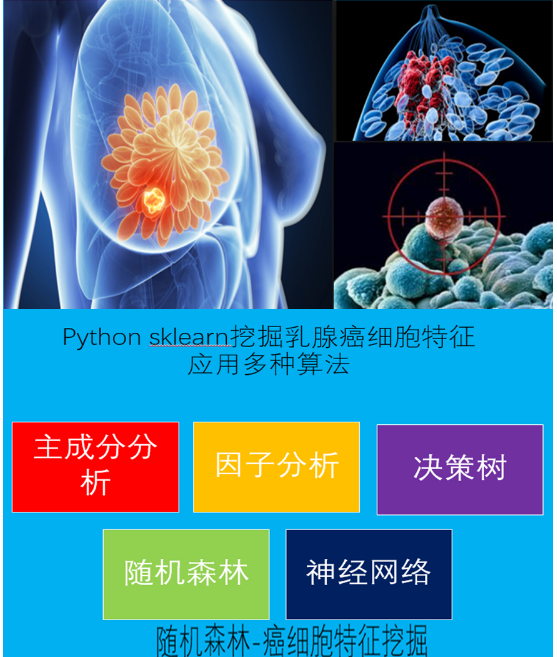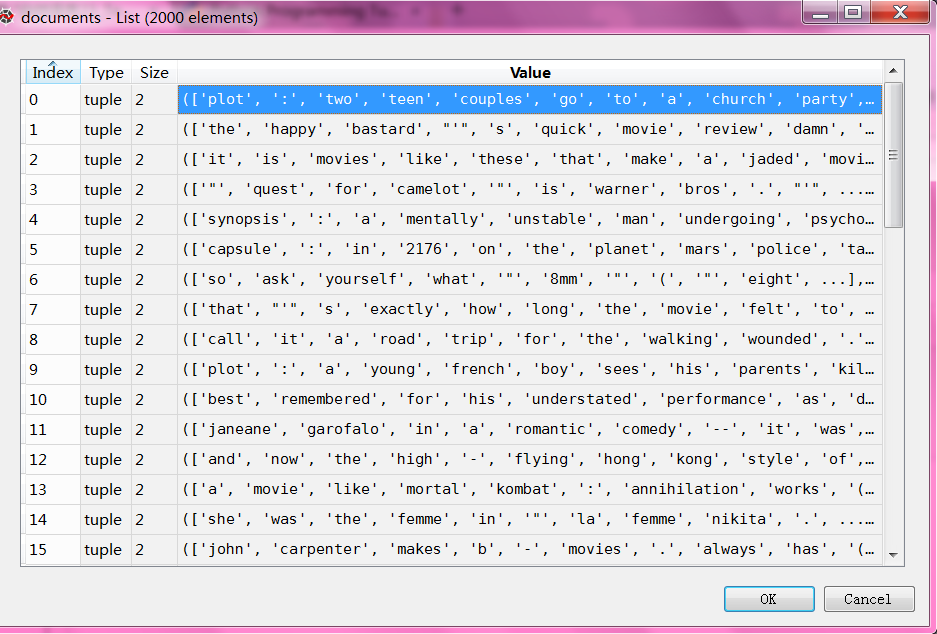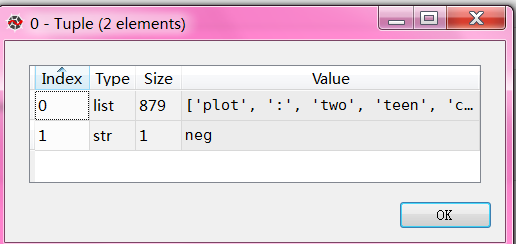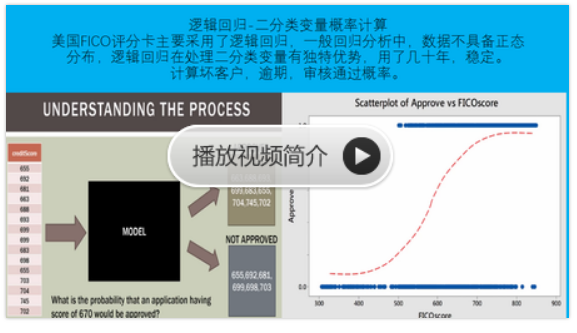自然语言23_Text Classification with NLTK
sklearn实战-乳腺癌细胞数据挖掘(博主亲自录制视频教程)

QQ:231469242
欢迎喜欢nltk朋友交流
https://www.pythonprogramming.net/text-classification-nltk-tutorial/?completed=/wordnet-nltk-tutorial/
Text Classification with NLTK
Now that we're comfortable with NLTK, let's try to tackle text
classification. The goal with text classification can be pretty broad.
Maybe we're trying to classify text as about politics or the military.
Maybe we're trying to classify it by the gender of the author who wrote
it. A fairly popular text classification task is to identify a body of
text as either spam or not spam, for things like email filters. In our
case, we're going to try to create a sentiment analysis algorithm.
To do this, we're going to start by trying to use the movie
reviews database that is part of the NLTK corpus. From there we'll try
to use words as "features" which are a part of either a positive or
negative movie review. The NLTK corpus movie_reviews data set has the
reviews, and they are labeled already as positive or negative. This
means we can train and test with this data. First, let's wrangle our
data.
import nltk
import random
from nltk.corpus import movie_reviews documents = [(list(movie_reviews.words(fileid)), category)
for category in movie_reviews.categories()
for fileid in movie_reviews.fileids(category)] random.shuffle(documents) print(documents[1]) all_words = []
for w in movie_reviews.words():
all_words.append(w.lower()) all_words = nltk.FreqDist(all_words)
print(all_words.most_common(15))
print(all_words["stupid"])
It may take a moment to run this script, as the movie reviews dataset is somewhat large. Let's cover what is happening here.
After importing the data set we want, you see:
documents = [(list(movie_reviews.words(fileid)), category)
for category in movie_reviews.categories()
for fileid in movie_reviews.fileids(category)]
Basically, in plain English, the above code is translated to: In each category (we have pos or neg), take all of the file IDs (each review has its own ID), then store the word_tokenized version (a list of words) for the file ID, followed by the positive or negative label in one big list.
Next, we use random to shuffle our documents. This is because we're going to be training and testing. If we left them in order, chances are we'd train on all of the negatives, some positives, and then test only against positives. We don't want that, so we shuffle the data.
Then, just so you can see the data you are working with, we print out documents[1], which is a big list, where the first element is a list the words, and the 2nd element is the "pos" or "neg" label.
Next, we want to collect all words that we find, so we can have a massive list of typical words. From here, we can perform a frequency distribution, to then find out the most common words. As you will see, the most popular "words" are actually things like punctuation, "the," "a" and so on, but quickly we get to legitimate words. We intend to store a few thousand of the most popular words, so this shouldn't be a problem.
print(all_words.most_common(15))
The above gives you the 15 most common words. You can also find out how many occurences a word has by doing:
print(all_words["stupid"])
Next up, we'll begin storing our words as features of either positive or negative movie reviews.
导入corpus语料库的movie_reviews 影评
all_words 是所有电影影评的所有文字,一共有150多万字
#all_words 是所有电影影评的所有文字,一共有150多万字
all_words=movie_reviews.words()
'''
all_words
Out[37]: ['plot', ':', 'two', 'teen', 'couples', 'go', 'to', ...] len(all_words)
Out[38]: 1583820
'''
影评的分类category只有两种,neg负面,pos正面
import nltk
import random
from nltk.corpus import movie_reviews for category in movie_reviews.categories():
print(category) '''
neg
pos
'''
列出关于neg负面的文件ID
movie_reviews.fileids("neg")
'''
'neg/cv502_10970.txt',
'neg/cv503_11196.txt',
'neg/cv504_29120.txt',
'neg/cv505_12926.txt',
'neg/cv506_17521.txt',
'neg/cv507_9509.txt',
'neg/cv508_17742.txt',
'neg/cv509_17354.txt',
'neg/cv510_24758.txt',
'neg/cv511_10360.txt',
'neg/cv512_17618.txt'
.......
'''
列出关于pos正面的文件ID
movie_reviews.fileids("pos")
'pos/cv989_15824.txt',
'pos/cv990_11591.txt',
'pos/cv991_18645.txt',
'pos/cv992_11962.txt',
'pos/cv993_29737.txt',
'pos/cv994_12270.txt',
'pos/cv995_21821.txt',
'pos/cv996_11592.txt',
'pos/cv997_5046.txt',
'pos/cv998_14111.txt',
'pos/cv999_13106.txt'
输出neg/cv987_7394.txt 的文字,一共有872个
list_words=movie_reviews.words("neg/cv987_7394.txt")
'''
['please', 'don', "'", 't', 'mind', 'this', 'windbag', ...]
'''
len(list_words)
'''
Out[30]: 872
'''
tuple1=(list(movie_reviews.words("neg/cv987_7394.txt")), 'neg')
'''
Out[32]: (['please', 'don', "'", 't', 'mind', 'this', 'windbag', ...], 'neg')
'''
#用列表解析最终比较方便
#展示形式多条(['please', 'don', "'", 't', 'mind', 'this', 'windbag', ...], 'neg')
documents = [(list(movie_reviews.words(fileid)), category)
for category in movie_reviews.categories()
for fileid in movie_reviews.fileids(category)]
一共有2000个文件

每个文件由一窜单词和评论neg/pos组成

完整测试代码
# -*- coding: utf-8 -*-
"""
Created on Sun Dec 4 09:27:48 2016 @author: daxiong
"""
import nltk
import random
from nltk.corpus import movie_reviews documents = [(list(movie_reviews.words(fileid)), category)
for category in movie_reviews.categories()
for fileid in movie_reviews.fileids(category)] random.shuffle(documents) #print(documents[1]) all_words = []
for w in movie_reviews.words():
all_words.append(w.lower()) all_words = nltk.FreqDist(all_words)
#print(all_words.most_common(15))
print(all_words["stupid"])
自然语言23_Text Classification with NLTK的更多相关文章
- 自然语言处理(1)之NLTK与PYTHON
自然语言处理(1)之NLTK与PYTHON 题记: 由于现在的项目是搜索引擎,所以不由的对自然语言处理产生了好奇,再加上一直以来都想学Python,只是没有机会与时间.碰巧这几天在亚马逊上找书时发现了 ...
- 自然语言20_The corpora with NLTK
QQ:231469242 欢迎喜欢nltk朋友交流 https://www.pythonprogramming.net/nltk-corpus-corpora-tutorial/?completed= ...
- 自然语言19.1_Lemmatizing with NLTK(单词变体还原)
QQ:231469242 欢迎喜欢nltk朋友交流 https://www.pythonprogramming.net/lemmatizing-nltk-tutorial/?completed=/na ...
- 自然语言14_Stemming words with NLTK
https://www.pythonprogramming.net/stemming-nltk-tutorial/?completed=/stop-words-nltk-tutorial/ # -*- ...
- 自然语言13_Stop words with NLTK
https://www.pythonprogramming.net/stop-words-nltk-tutorial/?completed=/tokenizing-words-sentences-nl ...
- 自然语言处理2.1——NLTK文本语料库
1.获取文本语料库 NLTK库中包含了大量的语料库,下面一一介绍几个: (1)古腾堡语料库:NLTK包含古腾堡项目电子文本档案的一小部分文本.该项目目前大约有36000本免费的电子图书. >&g ...
- python自然语言处理函数库nltk从入门到精通
1. 关于Python安装的补充 若在ubuntu系统中同时安装了Python2和python3,则输入python或python2命令打开python2.x版本的控制台:输入python3命令打开p ...
- Python自然语言处理实践: 在NLTK中使用斯坦福中文分词器
http://www.52nlp.cn/python%E8%87%AA%E7%84%B6%E8%AF%AD%E8%A8%80%E5%A4%84%E7%90%86%E5%AE%9E%E8%B7%B5-% ...
- 推荐《用Python进行自然语言处理》中文翻译-NLTK配套书
NLTK配套书<用Python进行自然语言处理>(Natural Language Processing with Python)已经出版好几年了,但是国内一直没有翻译的中文版,虽然读英文 ...
随机推荐
- 毕向东JAVA基础25天教程目录
视频目录:day01-01-基本常识day01-02-Java的跨平台性day01-03-Java环境搭建(安装)day01-04-Java环境搭建(环境变量配置)day01-05-Java环境搭建( ...
- 【CodeVS 3123】高精度练习之超大整数乘法 &【BZOJ 2197】FFT快速傅立叶
第一次写法法塔,,,感到威力无穷啊 看了一上午算导就当我看懂了?PS:要是机房里能有个清净的看书环境就好了 FFT主要是用了巧妙的复数单位根,复数单位根在复平面上的对称性使得快速傅立叶变换的时间复杂度 ...
- Spring中配置和读取多个Properties文件
一个系统中通常会存在如下一些以Properties形式存在的配置文件 1.数据库配置文件demo-db.properties: database.url=jdbc:mysql://localhost/ ...
- 控件(选择类): Selector, ComboBox
1.Selector(基类) 的示例Controls/SelectionControl/SelectorDemo.xaml <Page x:Class="Windows10.Contr ...
- IntelliJ IDEA 使用心得与常用快捷键
那种酸爽,根本说不出来—————————————————————————— by: Jimi没有BondJimi是谁? 就是洒家啊! 刚开始学习写Java的时候,用的eclipse,正式工作后,主 ...
- ON DUPLICATE KEY UPDATE
如果在INSERT语句末尾指定了ON DUPLICATE KEY UPDATE,并且插入行后会导致在一个UNIQUE索引或PRIMARY KEY中出现重复值,则在出现重复值的行执行UPDATE: 如果 ...
- awk 匹配不是 pattern 的内容
awk '/pattern/ {next} {print $0}' filename
- C++编译期多态与运行期多态
前言 今日的C++不再是个单纯的"带类的C"语言,它已经发展成为一个多种次语言所组成的语言集合,其中泛型编程与基于它的STL是C++发展中最为出彩的那部分.在面向对象C++编程中, ...
- [学习笔记]tarjan求割边
上午打模拟赛的时候想出了第三题题解,可是我不会求割边只能暴力判割边了QAQ 所以,本文介绍求割边(又称桥). 的定义同求有向图强连通分量. 枚举当前点的所有邻接点: 1.如果某个邻接点未被访问过,则访 ...
- 【BZOJ-1568】Blue Mary开公司 李超线段树 (标记永久化)
1568: [JSOI2008]Blue Mary开公司 Time Limit: 15 Sec Memory Limit: 162 MBSubmit: 557 Solved: 192[Submit ...

